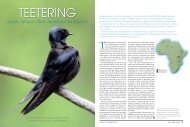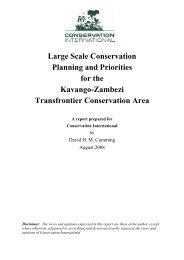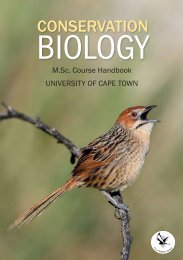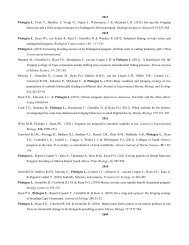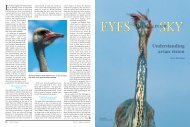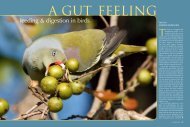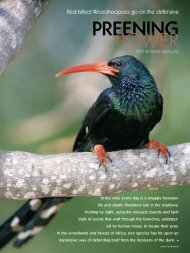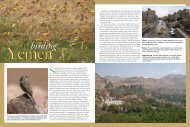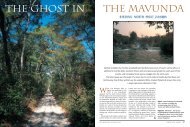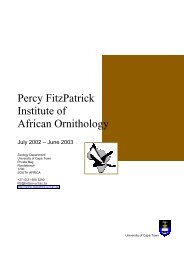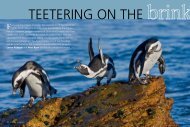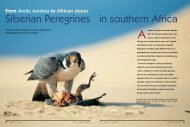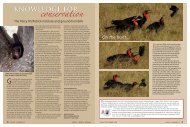Angels in camouflage: an appreciation of larks - Percy FitzPatrick ...
Angels in camouflage: an appreciation of larks - Percy FitzPatrick ...
Angels in camouflage: an appreciation of larks - Percy FitzPatrick ...
You also want an ePaper? Increase the reach of your titles
YUMPU automatically turns print PDFs into web optimized ePapers that Google loves.
mart<strong>in</strong> benadie<br />
n<strong>an</strong>cy bell<br />
Larks <strong>of</strong>fer us a unique snapshot <strong>of</strong><br />
Africa’s history, as they are <strong>an</strong> <strong>an</strong>cient<br />
group <strong>of</strong> birds that c<strong>an</strong> trace some <strong>of</strong> the<br />
cont<strong>in</strong>ent’s earliest geological events<br />
kilometres <strong>an</strong>d probably no more th<strong>an</strong><br />
100 <strong>in</strong>dividuals rema<strong>in</strong>. It is literally on<br />
the br<strong>in</strong>k <strong>of</strong> natural ext<strong>in</strong>ction.<br />
But m<strong>an</strong>y <strong>larks</strong> have <strong>in</strong>credibly small<br />
r<strong>an</strong>ges <strong>an</strong>d persist <strong>in</strong> m<strong>in</strong>uscule patches <strong>of</strong><br />
habitat. The genus Heteromirafra, compris<strong>in</strong>g<br />
South Africa’s Critically End<strong>an</strong>gered<br />
Rudd’s Lark, Ethiopia’s Sidamo Lark <strong>an</strong>d<br />
Somalia’s Archer’s Lark, is the most obvious<br />
group. With r<strong>an</strong>ges scattered widely<br />
across the cont<strong>in</strong>ent, each <strong>of</strong> these species<br />
occupies <strong>an</strong> exceptionally small global<br />
r<strong>an</strong>ge. Genetic work has revealed<br />
that Heteromirafra possibly represents<br />
<strong>an</strong> <strong>an</strong>cient l<strong>in</strong>eage that is slowly be<strong>in</strong>g<br />
replaced <strong>an</strong>d outcompeted by more<br />
dom<strong>in</strong><strong>an</strong>t <strong>larks</strong>.<br />
Larks <strong>of</strong>fer us a unique snapshot <strong>of</strong><br />
Africa’s history, as they are <strong>an</strong> <strong>an</strong>cient<br />
group <strong>of</strong> birds that c<strong>an</strong> trace some <strong>of</strong> the<br />
cont<strong>in</strong>ent’s early geological events. They<br />
are dom<strong>in</strong><strong>an</strong>t <strong>in</strong> Africa’s r<strong>an</strong>gel<strong>an</strong>ds <strong>an</strong>d,<br />
<strong>of</strong> all the bird families adapted to this<br />
habitat, they are also the most speciesrich<br />
group, with the most complex distribution<br />
patterns. All <strong>of</strong> these factors<br />
assist researchers’ <strong>in</strong>vestigations <strong>in</strong>to the<br />
poorly studied r<strong>an</strong>gel<strong>an</strong>ds.<br />
Of the 96 species <strong>of</strong> <strong>larks</strong> <strong>in</strong> the world,<br />
some 78 are found <strong>in</strong> Africa. They are<br />
concentrated <strong>in</strong> two ma<strong>in</strong> areas <strong>in</strong> particular:<br />
the south-west (South Africa,<br />
Botsw<strong>an</strong>a <strong>an</strong>d Namibia) <strong>an</strong>d the northeast<br />
(Ethiopia, Kenya <strong>an</strong>d Somalia), with<br />
26 <strong>an</strong>d 23 species respectively be<strong>in</strong>g<br />
endemic to these zones. Some theories<br />
propose that over m<strong>an</strong>y millions <strong>of</strong> years<br />
these two areas were connected (maybe<br />
a number <strong>of</strong> times) by <strong>an</strong> arid corridor,<br />
<strong>an</strong>d that <strong>in</strong> the process <strong>larks</strong> dispersed<br />
<strong>an</strong>d speciated across this corridor.<br />
Genetic research has turned up some<br />
fasc<strong>in</strong>at<strong>in</strong>g evidence <strong>in</strong> this regard. It<br />
seems that true desert <strong>larks</strong> did not disperse<br />
via the arid corridor. Instead, they<br />
appear to have evolved from neighbour<strong>in</strong>g<br />
<strong>larks</strong> <strong>an</strong>d have undergone radically<br />
divergent morphological evolution.<br />
A good example from southern Africa<br />
is Gray’s Lark. For m<strong>an</strong>y years it was<br />
thought to be closely related to the<br />
Ammom<strong>an</strong>es desert <strong>larks</strong> <strong>of</strong> North Africa<br />
because <strong>of</strong> their unc<strong>an</strong>ny mor phological<br />
similarity. However, Gray’s Lark’s closest<br />
relatives are other southern Afric<strong>an</strong><br />
<strong>larks</strong>, <strong>in</strong>clud<strong>in</strong>g the very dis similar Spikeheeled<br />
<strong>an</strong>d Long-billed lark complexes.<br />
Unlike true desert <strong>larks</strong>, semi-desert <strong>an</strong>d<br />
grassl<strong>an</strong>d <strong>larks</strong> do seem to have used<br />
Arid corridor<br />
the arid corridor for dispersal <strong>an</strong>d there<br />
are closely related species that occur at<br />
opposite ends <strong>of</strong> it, such as the Foxy Lark<br />
<strong>in</strong> the north <strong>an</strong>d the Fawn-coloured Lark<br />
<strong>in</strong> the south.<br />
While the study <strong>of</strong> <strong>larks</strong> is<br />
able to reveal <strong>in</strong>trigu<strong>in</strong>g<br />
patterns about the evolution<br />
<strong>of</strong> Africa’s arid zones,<br />
these hardy little birds also have <strong>an</strong> array<br />
<strong>of</strong> features that enable them to master<br />
the dry country.<br />
Feathers are the first. Larks are dullcoloured<br />
birds that have conservative<br />
plumage coloration <strong>an</strong>d patterns. There<br />
is a good reason for this: they require<br />
camou flage. In some <strong>larks</strong>, the colour <strong>of</strong><br />
their plumage is l<strong>in</strong>ked to that <strong>of</strong> the soil,<br />
<strong>an</strong>d their streak<strong>in</strong>g pattern is related to<br />
ve getation density. As r<strong>an</strong>gel<strong>an</strong>d specialists,<br />
these birds are placed under severe<br />
pressure from aerial predators, with<br />
falcons, kestrels <strong>an</strong>d sparrowhawks frequently<br />
overhead. When a lark is alarmed<br />
by a dist<strong>an</strong>t threat, it freezes, rely<strong>in</strong>g on<br />
its cryptic plumage to best effect. Only<br />
when a threat is extremely close does the<br />
bird flush.<br />
There are two ma<strong>in</strong> types <strong>of</strong> lark <strong>camouflage</strong><br />
plumage: generalised <strong>an</strong>d specialised.<br />
Generalised plumage comprises<br />
a mixture <strong>of</strong> colours with dark streak<strong>in</strong>g<br />
or spott<strong>in</strong>g on the feathers. This <strong>of</strong>fers<br />
crypsis <strong>an</strong>ywhere <strong>an</strong>d is particularly useful<br />
<strong>in</strong> a wide r<strong>an</strong>ge <strong>of</strong> vegetation backgrounds.<br />
Because <strong>of</strong> their varied habitat<br />
use, almost all migr<strong>an</strong>t <strong>an</strong>d nomadic<br />
<strong>larks</strong> (for example, the Somali Short-toed<br />
Lark) have generalised <strong>camouflage</strong>.<br />
Specialised <strong>camouflage</strong> tends to be<br />
uniform <strong>an</strong>d <strong>in</strong>volves a very close colour<br />
match with the tones <strong>of</strong> the bird’s<br />
favoured habitat. An excellent example <br />
The hypothetical arid corridor that may<br />
have persisted dur<strong>in</strong>g the ice ages <strong>an</strong>d at<br />
other periods dur<strong>in</strong>g Africa’s history obviously<br />
impacted on the evolution <strong>of</strong> some<br />
<strong>larks</strong>. However, its effect was limited for<br />
other groups, which seem to have evolved<br />
more <strong>in</strong> situ.<br />
Opposite, top The Dune Lark has<br />
plumage that matches almost exactly the<br />
substrate on which it lives <strong>in</strong> the Namib<br />
s<strong>an</strong>d-dune sea. It c<strong>an</strong> survive without<br />
freest<strong>an</strong>d<strong>in</strong>g water <strong>an</strong>d derives its water<br />
requirements from its food.<br />
Opposite, middle, left The Spike-heeled<br />
Lark is a species <strong>of</strong> open grassl<strong>an</strong>d <strong>an</strong>d<br />
semi-desert <strong>in</strong> southern Africa. Unusually,<br />
it breeds cooperatively <strong>an</strong>d uses aardvark<br />
burrows for shelter <strong>in</strong> hot climates.<br />
Opposite, middle, right The Sidamo<br />
Lark belongs to Heteromirafra, a genus<br />
apparently <strong>in</strong> ecological retreat, with all its<br />
members hav<strong>in</strong>g m<strong>in</strong>ute r<strong>an</strong>ges scattered<br />
across Africa.<br />
Opposite, bottom Gillett’s Lark, a scarce<br />
local resident <strong>in</strong> arid country <strong>in</strong> northeastern<br />
Africa, is related to the Karoo<br />
<strong>an</strong>d Dune <strong>larks</strong> <strong>of</strong> southern Africa – a<br />
good example <strong>of</strong> speciation along the<br />
arid corridor.<br />
august/september 2009<br />
<strong>larks</strong><br />
53<br />
keith barnes (2)



